MV Bellubera
Bellubera was a ferry operated by the Port Jackson & Manly Steamship Company on the Manly service. Launched in 1910, she was the third of six "Binngarra-type" vessels. Upon her 1936 conversion from steam power, she became the first diesel-electric vessel in Australia. She was decommissioned in 1973, and scuttled at sea in 1980.
 Bellubera as a steam ship in her original configuration | |
| History | |
|---|---|
| Name: | Bellubera |
| Operator: | Port Jackson & Manly Steamship Company |
| Port of registry: | Sydney |
| Route: | Manly |
| Builder: | Mort's Dock |
| Launched: | 26 April 1910 |
| Out of service: | 29 November 1973 |
| Identification: | IMO number: 5040043 |
| Fate: | Scuttled 1 August 1980 |
| General characteristics | |
| Tonnage: | 499 tons (1936: 505 tons) |
| Length: | 63 metres |
| Beam: | 9.75 metres |
| Decks: | 2 |
Due to many misfortunes in her 63-year service life, she was nicknamed the Hoodoo Ship. Two of her masters died at the wheel, two crew members died when she was gutted by fire in 1936, and the owner of a motor launch was killed when the Bellubera ran it down and sank her.
The name "bellubera" is thought to be an Australian Aboriginal word meaning "pretty lady" or "beautiful woman".[1]
Service history and configuration changes
Bellubera was built by Mort's Dock and Engineering Co, Woolwich, New South Wales, Australia, for the Port Jackson & Manly Steamship Company. Launched on 6 April 1910 by Mrs J. Fyfe,[2] she was the third of six Binngarra-type vessels. She was a near identical sister to Barrenjoey (later North Head) and Balgowlah (1912), and similar to the slightly smaller Binngarra (1905), Burra Bra (1908) and Baragoola (1922). She was 499 tons and 64.0 m long. As built, she was powered by triple expansion steam engine providing 123 hp and was able to make up to 15 knots.[3]
The exorbitant cost and difficulty in replacing the large expensive steel hulled Binngarra-type vessels saw the Bellubera, along with the Balgowlah, Barrenjoey, and Baragoola retained and significantly modified. In the 1920s, all four had officers' cabins attached to their wheelhouses. Beginning with Barrenjoey in 1930, and then in 1931-32 Balgowlah, Baragoola, and Bellubera over 1931-32, had their open upper passenger decks enclosed.

In 1936 with her boilers nearing the end of their service life, Bellubera's original steam engines were replaced by four five-cylinder Harland & Wolff diesel engines (1,800 bhp) which drove two British Thompson-Houston diesel engineers, which could push her to 16 knots. Her single funnel was replaced by two, the second funnel being a dummy mounted for appearance. She became the first diesel-electric powered vessel in Australia.[3] The new engines increased her service speed to 18 knots, but increased vibrations throughout the vessel making her less popular with passengers.
In 1948, Bellubera, along with Balgowlah, Baragoola, was fitted with the larger wheelhouse/cabin structures that they would sport until the rest of their ferry careers. In 1954, she was taken to the State Dockyard where she was partially replated, repainted, and re-engined with three seven-cylinder British Thompson-Houston diesel engines that drove 2 English Electric electric engines.[3]
Misadventures
Due to many misfortunes, she was nicknamed the Hoodoo Ship. She collided with at least four vessels, sinking two of them, seven people died through direct association with the ferry and at least seven people fell or jumped off the ferry.[4]

On 2 April 1914, she collided with the steam tug Kate off Dobroyd Head, sinking Kate in seconds and capsizing the lighter Kate was towing; Bellubera rescued Kate′s four-man crew. In 1933, Bellubera collided with the smaller ferry, Kai Kai.[1]
On 16 November 1936, fire broke out aboard Bellubera while she was moored at the Kurraba Point depot while workmen were repairing a steel plate on the roof of the upper deck. A welder's oxy-acetylene torch set alight the leather seats in the saloon and within five minutes the entire ship was ablaze. Four men were trapped below decks, with one dying that night in hospital and a second a few days later. Another suffered leg burns and spent 21 months in hospital.[4][5][6] The superstructure was gutted and the hull significantly damaged. Bellubera was rebuilt at the Cockatoo Island Dockyard and re-entered service in October 1937.[1]
In 1940, collided with the 30-foot launch, Sydbridge, cutting the boat in half and sinking it with its owner whose body was found nine days later.[1] On 6 February 1946, her master, Captain William Dohrn, collapsed and died at the wheel as the vessel was making its way across the Heads towards Manly. On 5 September of that year, a young women fell overboard. In 1946, a passenger fell overboard and drowned, and in the same year, Bellubera collided with a navl launch killing the helmsman.[7] In October 1960, Bellubera collided with the 7,000-ton Norwegian freighter Taurus but received only minor damage continuing her run to Circular Quay. Her master, Captain Albert Villiers, died at the wheel in February 1961 while berthing her at the Kurraba Point depot. Five years later Bellubera collided with the dredge WD66.[1][7]
On 28 February 1970, en route from Manly, Bellubera collided with the Australian Navy Ship, HMAS Parramatta as it was backing out of the naval depot near Chowder Bay. She inflicted a 2 m x 3 m hole in the warship, whilst only suffering minor damage herself. Navy personnel covered the Parramatta's damage with a tarpaulin to hide it from press photographers, while Bellubera resumed her journey.[1] On 23 July 1973, heavy seas damamged doors and seats.[7]
Retirement and demise
Bellubera was taken out of service on 29 November 1973.[4][5] Her service life of sixty-three years was a record for a Manly ferry, that would be beaten by the North Head, formerly Barrenjoey (1913-1985).[8] At this time, the Manly services had been taken over by Brambles Limited and the service struggled and ships were in poor condition.[7] She was sold in 1975 to a company named Trouble Shooter, so certain equipment could be stripped and installed into the ex-Royal Australian Navy Ton-class minesweeper HMAS Gull. Bellubera′s English Electric diesels were removed and returned to the Public Transport Commission to support the Baragoola and North Head in service. Bellubera was towed to sea by tug Betts Bay and scuttled off Long Reef on 1 August 1980 and today rests on her side in two pieces in 45 metres (148 feet) of water.[4][5]
Gallery
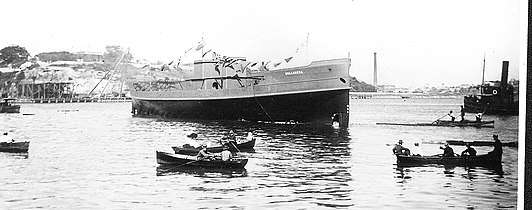 Launch day, 26 April 1910
Launch day, 26 April 1910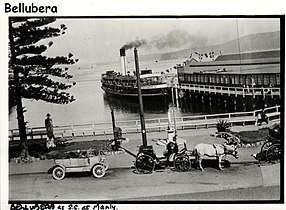 At Manly Wharf in as-built condition, 1910s
At Manly Wharf in as-built condition, 1910s With extended wheelhouses and original open upper decks, 1930s
With extended wheelhouses and original open upper decks, 1930s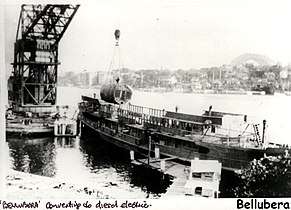 Removal of boiler during conversion from steam to diesel-electric propulsion, 1935/36
Removal of boiler during conversion from steam to diesel-electric propulsion, 1935/36 Conversion to diesel-electric, 1936
Conversion to diesel-electric, 1936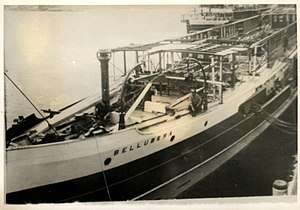 Rebuild of superstructure during conversion to diesel-electric propulsion
Rebuild of superstructure during conversion to diesel-electric propulsion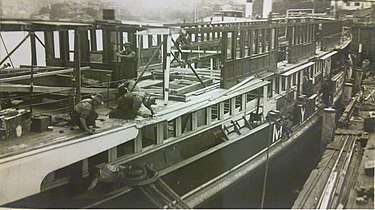 Rebuild of superstructure during conversion to diesel-electric propulsion
Rebuild of superstructure during conversion to diesel-electric propulsion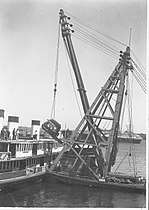 One of four new diesel generators are lowered into the place during conversion to diesel-electric, 1936
One of four new diesel generators are lowered into the place during conversion to diesel-electric, 1936 Post diesel-electric conversion and prior to fire, 1936
Post diesel-electric conversion and prior to fire, 1936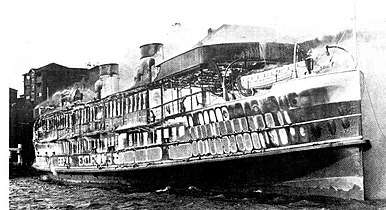 Well alight, Kurraba Point base 1936. Two crew died.
Well alight, Kurraba Point base 1936. Two crew died.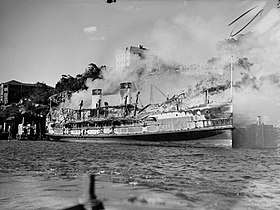 Superstructure collapses, 1936 fire Kurraba Point. Two crew died.
Superstructure collapses, 1936 fire Kurraba Point. Two crew died. After the fire. People watch from Kurraba Road above
After the fire. People watch from Kurraba Road above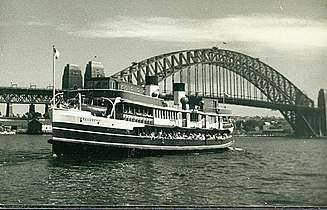 At Circular Quay, rebuilt after the devasting fire, 1938
At Circular Quay, rebuilt after the devasting fire, 1938 Laid up with the larger South Steyne, Balmain 1970s
Laid up with the larger South Steyne, Balmain 1970s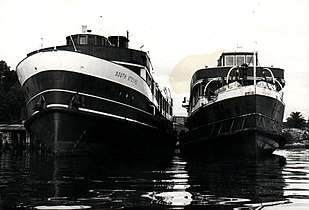 Laid up along side the South Steyne, 1975
Laid up along side the South Steyne, 1975
See also
References
- Morcombe, John (26 May 2019). "The Bellubera Had Its Fair Share of Controversies During Its Time". The Manly Daily. Retrieved 6 June 2019.
- Andrews, Graeme (1982). A Pictorial History of Ferries: Sydney and Surrounding Waterways. Sydney: AH & AW Reed Pty Ltd. p. 47. ISBN 0589503863.
- Prescott, AM (1984). Sydney Ferry Fleet. Magill South Australia: Ronald H Parsons. p. 59. ISBN 0909418306.
- Bellubera Ferries of Sydney
- Mead, Tom (1988). Manly Ferries of Sydney Harbour. Brookvale: Child & Associates. p. 164. ISBN 0 86777 091 0.
- Manly Ferry Fire Sydney Morning Herald 9 December 1936
- Andrews, Graeme (1975). The Ferries of Sydney. A.H. & A.W. Reed Pty Ltd. pp. 45–47. ISBN 0589071726.
- Andrews, Graeme (1982). A Pictorial History of Ferries: Sydney and Surrounding Waterways. Sydney: AH & AW Reed Pty Ltd. p. 47. ISBN 0589503863.
External links
